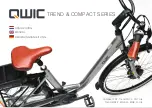
54
55
G
Brake cables which are damaged, e.g. frayed
(a)
, must be
replaced immediately, as they can otherwise fail in a critical
moment, possibly causing a crash!
G
Adjusting the position of the brake pads relative to the rims
requires a considerable degree of skill. Replacing and ad-
justing the brake pads is a job best left to your BiXS bicycle
dealer.
G
Have your rims regularly inspected and measured by your
BiXS bicycle dealer.
Synchronising and Readjusting
Almost all brake designs have a bolt located next to one or both brake
callipers to adjust the initial spring tension
(b)
. Turn the bolt slowly and
watch how the gap changes between the brake pads and the rim.
Adjust the spring in a way that with an unapplied brake the gaps are
equal on either side and the brake pads touch the rim simultaneously
during braking.
The position of the brake lever where the brake starts to act, also re-
ferred to as the pressure point, can be adjusted to the size of the hand
as well as to individual convenience by readjusting the brake cable.
Make absolutely sure you cannot pull the brake lever all the way to the
handlebar grip. With an unapplied brake the brake pads should not
be too close to the rim sides, otherwise they could drag along the rim
during riding. Before doing this adjustment, observe the notes in the
chapter
“adjusting the brake lever reach”
.
To readjust the brakes, unscrew the knurled lock ring located at the
point where the brake cable enters the brake lever on the handlebars
(c)
. Unscrew the knurled, slotted adjusting bolt by a few turns. This
reduces the free travel of the brake lever. Keeping the adjusting bolt
firm, tighten the lock ring against the brake lever unit. This prevents the
adjusting bolt from coming loose by itself. Ensure that the slot of the bolt
faces neither forward nor upward, as this would permit water or dirt to
enter more easily.
G
Always test the brakes’ function when stationary
(d)
after
adjusting them, making sure the brake pads engage fully
with the rim when you pull them hard.
DISC BRAKES
operation and Wear
The most striking feature of disc brakes is their outstanding braking
power. They respond a lot faster in wet conditions than rim brakes do
and achieve their normal high braking power within a very short time.
They require little maintenance and do not wear down the rims as rim
brakes do. Disc brakes consist of the brake calliper
(e)
, the rotor
(f)
, the
brake lines or cables as well as the brake lever unit
(g)
. Actuating the
brake lever compresses the hydraulic pistons through hydraulic pres-
sure or mechanically, pushing the brake pads against the rotor.
The friction generated by braking causes wear to the brake pads
(h)
as
well as to the rotors. Frequent rides in the rain and dirt and over hilly ter-
rain can accelerate wear of the brake pads and the rotors. Depending
on the manufacturer and the model there are different ways of checking
the brake pads and rotors for their wear limits.
G
New brake pads have to be bedded in before they reach
their optimal braking performance. For this purpose, accel-
erate your BiXS bicycle 30 to 50 times to around 30 kph
(18 mph) and bring it to a halt each time. This procedure
is finished, when the force required at the lever for braking
has stopped decreasing.
G
Disc brakes get hot in use. For this reason do not touch the
rotors directly after stopping, especially after a long down-
hill ride.
G
Dirty brake pads and rotors can lead to drastically reduced
braking power. Therefore, make sure the brake remains
free of oil and other fluids, especially when you clean your
BiXS bicycle or grease the chain. Dirty brake pads cannot
be cleaned under any circumstances, they must be re-
placed! Rotors can be cleaned with special brake cleaners
or with warm water and mild soap.
G
Unusual noises (scratching, chafing etc.) during braking
and/or a noticeable change of the braking force (stronger
or weaker) are indications that the brake pads are soiled
or worn down. Check the brake pads and replace them, if
necessary. otherwise you risk further damage, e.g. to the
rotor, or even an accident due to brake failure! If you are in
doubt, contact your BiXS bicycle dealer.
a
b
c
d
e
f
g
h
Summary of Contents for Chamois
Page 69: ......
















































